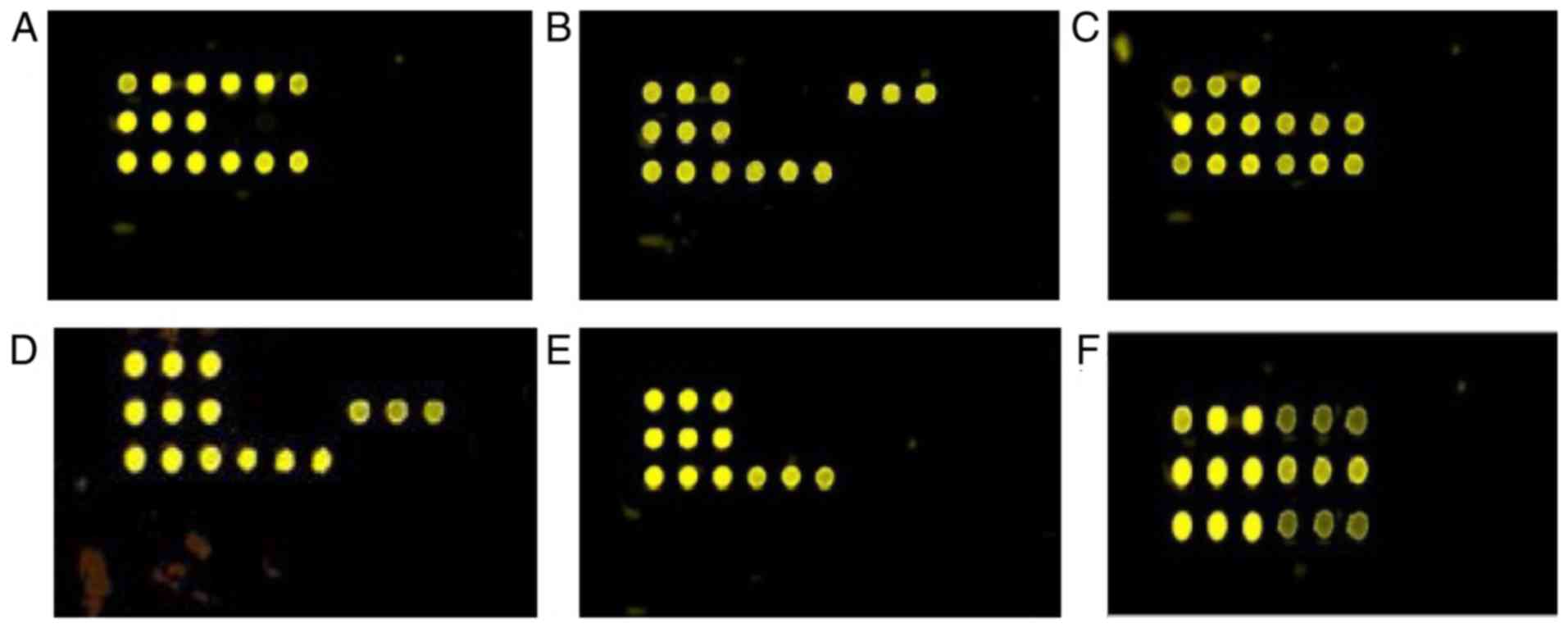|
1
|
Amin M, Ghaderpanah M and Navidifar T:
Detection of Haemophilus influenzae type b, Streptococcus
agalactiae, Streptococcus pneumoniae and Neisseria
meningitidis in CSF specimens of children suspicious of
Meningitis in Ahvaz, Iran. Kaohsiung J Med Sci. 32:501–506. 2016.
View Article : Google Scholar : PubMed/NCBI
|
|
2
|
Taj A and Jamil N: Detection of
meningococcal meningitis in cerebrospinal fluid of patients with
neurological disorders in government hospitals of Karachi. J Pak
Med Assoc. 66:1418–1421. 2016.PubMed/NCBI
|
|
3
|
Bøving MK, Pedersen LN and Møller JK:
Eight-Plex PCR and liquid-array detection of bacterial and viral
pathogens in cerebrospinal fluid from patients with suspected
meningitis. J Clin Microbiol. 47:908–913. 2009. View Article : Google Scholar : PubMed/NCBI
|
|
4
|
Gade L, Scheel CM, Pham CD, Lindsley MD,
Iqbal N, Cleveland AA, Whitney AM, Lockhart SR, Brandt ME and
Litvintseva AP: Detection of fungal DNA in human body fluids and
tissues during a multistate outbreak of fungal meningitis and other
infections. Eukaryot Cell. 12:677–683. 2013. View Article : Google Scholar : PubMed/NCBI
|
|
5
|
Khater WS and Elabd SH: Identification of
common bacterial pathogens causing meningitis in culture-negative
cerebrospinal fluid samples using real-time polymerase chain
reaction. Int J Microbiol. 2016:41971872016. View Article : Google Scholar : PubMed/NCBI
|
|
6
|
Sarookhani MR, Ayazi P, Alizadeh S,
Foroughi F, Sahmani A and Adineh M: Comparison of 16S rDNA-PCR
amplification and culture of cerebrospinal fluid for diagnosis of
bacterial meningitis. Iran J Pediatr. 20:471–475. 2010.PubMed/NCBI
|
|
7
|
Xiao X, Zhang Y, Zhang L, Kang P and Ji N:
The diagnostic value of cerebrospinal fluid lactate for
post-neurosurgical bacterial meningitis: A meta-analysis. BMC
Infect Dis. 16:4832016. View Article : Google Scholar : PubMed/NCBI
|
|
8
|
Shen J, Guan Y, Zhang J, Tang J, Lu X and
Zhang C: Application of microarray technology for the detection of
intracranial bacterial infection. Exp Ther Med. 7:496–500. 2014.
View Article : Google Scholar : PubMed/NCBI
|
|
9
|
Lin AL and Safdieh JE: The evaluation and
management of bacterial meningitis: Current practice and emerging
developments. Neurologist. 16:143–151. 2010. View Article : Google Scholar : PubMed/NCBI
|
|
10
|
Rajesh NT, Dutta S, Prasad R and Narang A:
Effect of delay in analysis on neonatal cerebrospinal fluid
parameters. Arch Dis Child Fetal Neonatal Ed. 95:F25–F29. 2010.
View Article : Google Scholar : PubMed/NCBI
|
|
11
|
de Filippis I, de Andrade CF, Caldeira N,
de Azevedo AC and de Almeida AE: Comparison of PCR-based methods
for the simultaneous detection of Neisseria meningitidis,
Haemophilus influenzae and Streptococcus pneumoniae in
clinical samples. Braz J Infect Dis. 20:335–341. 2016. View Article : Google Scholar : PubMed/NCBI
|
|
12
|
Leveque N, Van Haecke A, Renois F,
Boutolleau D, Talmud D and Andreoletti L: Rapid virological
diagnosis of central nervous system infections by use of a
multiplex reverse transcription-PCR DNA microarray. J Clin
Microbiol. 49:3874–3879. 2011. View Article : Google Scholar : PubMed/NCBI
|
|
13
|
Esparcia O, Montemayor M, Ginovart G,
Pomar V, Soriano G, Pericas R, Gurgui M, Sulleiro E, Prats G,
Navarro F and Coll P: Diagnostic accuracy of a 16S ribosomal DNA
gene-based molecular technique (RT-PCR, microarray and sequencing)
for bacterial meningitis, early-onset neonatal sepsis and
spontaneous bacterial peritonitis. Diagn Microbiol Infect Dis.
69:153–160. 2011. View Article : Google Scholar : PubMed/NCBI
|
|
14
|
Srinivasan L, Pisapia JM, Shah SS, Halpern
CH and Harris MC: Can broad-range 16S ribosomal ribonucleic acid
gene polymerase chain reactions improve the diagnosis of bacterial
meningitis? A systematic review and meta-analysis. Ann Emerg Med.
60:609–620.e2. 2012. View Article : Google Scholar : PubMed/NCBI
|
|
15
|
Klindworth A, Pruesse E, Schweer T,
Peplies J, Quast C, Horn M and Glöckner FO: Evaluation of general
16S ribosomal RNA gene PCR primers for classical and
next-generation sequencing-based diversity studies. Nucleic Acids
Res. 41:e12013. View Article : Google Scholar : PubMed/NCBI
|
|
16
|
Liu A, Wang, C1 Liang Z, Zhou ZW, Wang L,
Ma Q, Wang G, Zhou SF and Wang Z: High-throughput sequencing of 16S
rDNA amplicons characterizes bacterial composition in cerebrospinal
fluid samples from patients with purulent meningitis. Drug Des
Devel Ther. 9:4417–4429. 2015.PubMed/NCBI
|
|
17
|
Zhong D, Koepfli C, Cui L and Yan G:
Molecular approaches to determine the multiplicity of
Plasmodium infections. Malar J. 17:1722018. View Article : Google Scholar : PubMed/NCBI
|
|
18
|
Bumgarner R: Overview of DNA microarrays:
Types, applications and their future. Curr Protoc Mol Biol.
101:22.1.1–22.1.11. 2013.
|
|
19
|
McCarthy MW and Walsh TJ: PCR methodology
and applications for the detection of human fungal pathogens.
Expert Rev Mol Diagn. 16:1025–1036. 2016. View Article : Google Scholar : PubMed/NCBI
|
|
20
|
Rupp S: Microarray technologies in fungal
diagnostics. Methods Mol Biol. 1508:385–409. 2017. View Article : Google Scholar : PubMed/NCBI
|
|
21
|
Ben RJ, Kung S, Chang FY, Lu JJ, Feng NH
and Hsieh YD: Rapid diagnosis of bacterial meningitis using a
microarray. J Formos Med Assoc. 107:448–453. 2008. View Article : Google Scholar : PubMed/NCBI
|
|
22
|
Patel A and Cheung SW: Application of DNA
microarray to clinical diagnostics. Methods Mol Biol. 1368:111–132.
2016. View Article : Google Scholar : PubMed/NCBI
|
|
23
|
Raich T and Powell S: Identification of
bacterial and fungal pathogens from positive blood culture bottles:
A microarray-based approach. Methods Mol Biol. 1237:73–90. 2015.
View Article : Google Scholar : PubMed/NCBI
|
|
24
|
van Veen SQ, Claas EC and Kuijper EJ:
High-throughput identification of bacteria and yeast by
matrix-assisted laser desorption ionization-time of flight mass
spectrometry in conventional medical microbiology laboratories. J
Clin Microbiol. 48:900–907. 2010. View Article : Google Scholar : PubMed/NCBI
|


















